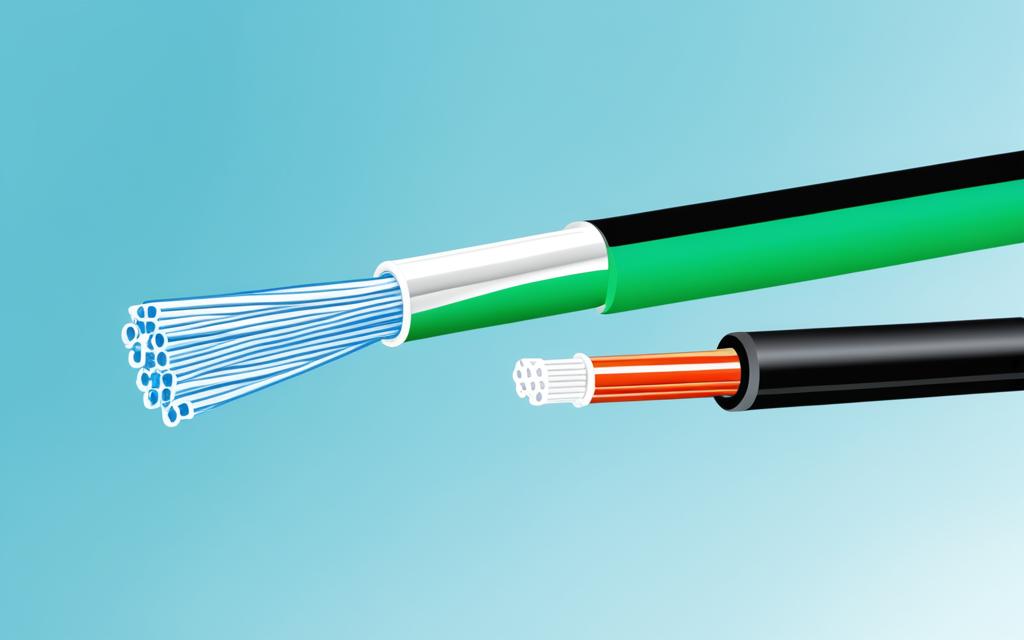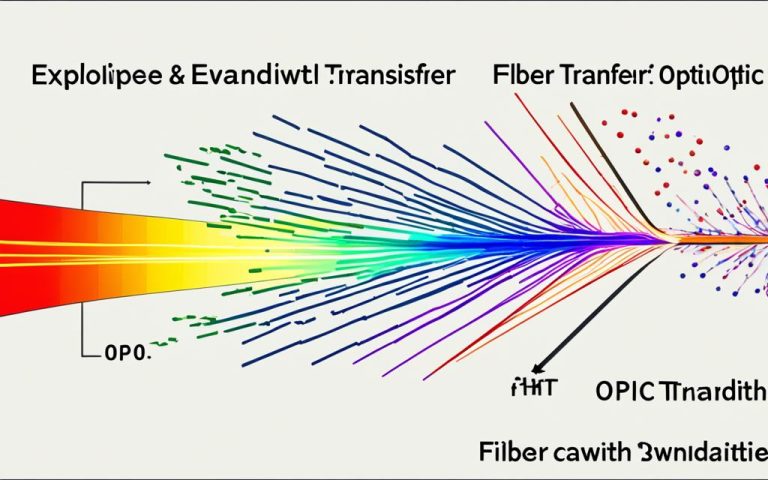Fiber optic networks play a critical role in modern telecommunications, providing high-speed data transmission. However, maintaining network reliability and minimizing latency are key challenges for organizations. In this article, we will explore the importance of fiber optic network redundancy and how it contributes to overall network reliability.
To achieve maximum reliability, organizations need to design fiber optic networks that incorporate redundancy measures. Redundancy ensures that the network can continue to operate seamlessly even in the event of hardware failures or disruptions. This is achieved by implementing backup options, such as additional devices or alternative communication mediums, which can automatically take over if the primary components fail.
Network reliability is crucial for businesses that rely on real-time communication and applications. Downtime can result in significant financial losses and damage to reputation. By designing redundant fiber optic networks, organizations can minimize the risk of service interruptions and ensure uninterrupted connectivity for their users.
In the next sections, we will dive deeper into the various aspects of designing redundant fiber optic networks. We will explore how to assess network needs and goals, choose the right components, minimize losses and errors, optimize routing and switching, and effectively monitor and troubleshoot the network. Along the way, we will discuss best practices and strategies to achieve maximum reliability and low latency.
Let’s begin by examining the importance of assessing network needs and goals in the context of fiber optic network redundancy.
Assessing Network Needs and Goals
The first step in designing a redundant fiber optic network is to assess the needs and goals of the network. To ensure optimal performance and reliability, it is crucial to determine the specific requirements and objectives of the network.
Some key factors to consider when assessing network needs include:
- Bandwidth: Determine the amount of data that needs to be transmitted over the network. This will help in selecting the appropriate capacity and speed of the fiber optic cables.
- Distance: Consider the physical distance that the network needs to cover. Longer distances may require special considerations, such as the use of fiber amplifiers or repeaters.
- Reliability: Identify the level of reliability required for the network. This can include factors such as uptime, availability, and fault tolerance.
- Security Requirements: Assess the security needs of the network, including encryption, authentication, and access controls.
- Number of Users and Devices: Determine the number of users and devices that will be connected to the network. This will help in determining the capacity and scalability requirements.
- Sensitivity to Latency: Identify applications that are sensitive to latency, such as real-time communication or high-frequency trading. This will help in designing a network with low latency.
By carefully assessing these factors, organizations can determine the appropriate type, size, and configuration of the fiber optic network that will best meet their needs and goals.
Case Study: Network Needs Assessment
“When we were designing our fiber optic network, it was crucial for us to assess our needs and goals accurately. By carefully evaluating factors such as bandwidth, distance, and reliability, we were able to design a network that met our specific requirements. This allowed us to provide our customers with a reliable and high-speed internet connection, ensuring their satisfaction and loyalty.”
| Factors to Assess | Description |
|---|---|
| Bandwidth | The amount of data that needs to be transmitted over the network. |
| Distance | The physical distance that the network needs to cover. |
| Reliability | The level of reliability required for the network. |
| Security Requirements | The security needs of the network, including encryption and access controls. |
| Number of Users and Devices | The number of users and devices that will be connected to the network. |
| Sensitivity to Latency | The applications that are sensitive to latency. |
Choosing Components for the Network
Once the network needs and goals are established, the next crucial step in designing a fiber optic network is selecting the right components. The components form the building blocks of the network and determine its performance, reliability, and scalability. Key components include fiber optic cables, connectors, transceivers, switches, and routers, among others.
When selecting fiber optic cables, it is important to consider factors such as bandwidth requirements, distance limitations, and environmental conditions. Opting for cables with higher bandwidth capacity ensures efficient data transmission, while considering distance limitations allows for proper planning and deployment. Additionally, choosing cables built to withstand harsh environments guarantees durability and long-term performance.
Connectors play a critical role in establishing reliable connections between fiber optic cables. Selecting connectors with good mating characteristics and low insertion loss is essential for minimizing signal degradation and ensuring seamless transmission. Consideration should also be given to connector compatibility with chosen cable types and ease of installation.
Transceivers are another integral component of a fiber optic network. They convert electrical signals into optical signals for transmission over the fiber optic cables and vice versa. When choosing transceivers, factors such as data rate, reach, power consumption, and compatibility with network equipment should be taken into account. Opting for transceivers that align with network requirements ensures optimal performance and compatibility.
“Choosing the right components is crucial for building a reliable and efficient fiber optic network.”
| Component | Considerations |
|---|---|
| Fiber Optic Cables | – Bandwidth requirements – Distance limitations – Environmental conditions |
| Connectors | – Mating characteristics – Insertion loss – Compatibility with cables – Ease of installation |
| Transceivers | – Data rate – Reach – Power consumption – Compatibility with network equipment |
| Switches and Routers | – Scalability – Network management capabilities – Compatibility with other components |
Switches and routers are essential for managing network traffic and ensuring proper data routing. When selecting these components, factors such as scalability, network management capabilities, and compatibility with other network equipment should be considered. Choosing switches and routers that align with the network’s capacity and requirements allows for efficient data transmission and network management.
“The careful selection of fiber optic network components lays the foundation for a reliable and high-performance network.”
By carefully selecting fiber optic network components, organizations can build a robust and reliable network infrastructure that meets their specific needs and goals. Compatibility, durability, and quality should be prioritized to ensure optimal performance and future scalability.
Minimizing Losses and Errors
In order to ensure low latency in a fiber optic network, it is crucial to minimize losses and errors that can occur during data transmission. These losses and errors can be caused by various factors such as bending, splicing, reflection, dispersion, interference, or noise. By implementing proper installation techniques, utilizing alignment tools, employing testing equipment, and following effective maintenance practices, organizations can minimize the impact of these issues and maintain optimal network performance.
One effective approach to minimizing losses and errors is through the use of attenuators, which help in reducing the signal strength to avoid distortion or saturation. Attenuators play a critical role in maintaining the integrity of light signals and ensuring accurate data transmission over long distances.
Additionally, the use of amplifiers, repeaters, or compensators can help to strengthen or restore signal quality, compensating for losses that occur due to distance or other factors. These devices play a crucial role in boosting the optical power levels and maintaining a consistent signal strength throughout the network.
“Reducing losses and errors in fiber optic networks is paramount for achieving optimal performance and minimizing data transmission issues.”
Benefits of Minimizing Losses and Errors
By actively minimizing losses and errors, organizations can experience the following benefits:
- Enhanced data transmission: Minimizing losses and errors improves the overall quality of data transmission, allowing for faster, more reliable communication.
- Reduced latency: By attenuating light signals and reducing errors, organizations can significantly reduce latency, ensuring a seamless user experience.
- Improved network reliability: A network with minimized losses and errors is more robust and less prone to disruptions, resulting in increased network uptime and availability.
- Optimized bandwidth utilization: Minimizing losses and errors enables organizations to make the most efficient use of available bandwidth, maximizing network capacity.

| Loss/Errors | Causes | Solution |
|---|---|---|
| Bending | Tight bends or excessive curvature of fiber optic cables | Use appropriate cable slack management techniques and avoid sharp bends |
| Reflection | Light signals bouncing back from connectors, splices, or interfaces | Ensure proper alignment of connectors and the use of anti-reflective coatings |
| Dispersion | Separation of light signals into different wavelengths or modes | Utilize dispersion-compensating fibers or dispersion compensators |
| Interference | External electromagnetic or radio frequency interference | Protect the fiber optic cables from interference sources and utilize shielding techniques |
| Noise | Unwanted fluctuations or disturbances in the light signals | Implement effective noise reduction techniques and use high-quality components |
Minimizing losses and errors is a crucial aspect of designing a reliable and high-performing fiber optic network. By addressing these issues through proper installation, alignment, testing, and maintenance practices, organizations can ensure optimal data transmission and reduce latency, ultimately enhancing network performance and user satisfaction.
Optimizing Routing and Switching
The routing and switching processes play a crucial role in the performance of fiber optic networks. These processes determine how light signals are directed and delivered, impacting latency and overall network efficiency. Optimizing routing and switching is essential to minimize delays, congestion, and the number of hops in the network. By implementing efficient algorithms, load balancing techniques, traffic shaping, and quality of service methods, organizations can prioritize and manage the flow of data effectively.
Efficient algorithms enable more streamlined routing and switching, reducing latency and maximizing network capacity. Load balancing techniques distribute network traffic evenly across available resources, preventing bottlenecks and optimizing resource utilization. Traffic shaping allows for the prioritization and regulation of data flow, ensuring that critical applications receive the necessary bandwidth and minimizing latency for real-time communication.
Benefits of Optimizing Routing and Switching
- Improved network performance and reduced latency
- Enhanced resource utilization and capacity management
- Minimized congestion and improved overall network efficiency
- Improved quality of service and prioritization of critical applications
Efficient routing and switching in fiber optic networks are crucial for providing a seamless and high-quality user experience. By optimizing these processes, organizations can ensure that data flows smoothly and efficiently, minimizing latency and maximizing network performance.
| Optimization Technique | Advantages |
|---|---|
| Efficient Algorithms |
|
| Load Balancing |
|
| Traffic Shaping |
|
| Quality of Service |
|
Monitoring and Troubleshooting the Network
To ensure the reliability and optimal performance of your fiber optic network, continuous monitoring and troubleshooting are essential. By implementing robust monitoring tools and employing effective troubleshooting techniques, you can proactively detect, analyze, and resolve any issues or problems that may arise.
Monitoring Fiber Optic Networks:
Monitoring fiber optic networks involves measuring and analyzing various network parameters to ensure optimal performance. By monitoring key metrics such as latency, signal strength, error rates, and bandwidth utilization, you can gain valuable insights into the health and performance of your network.
Troubleshooting Network Issues:
When network issues occur, prompt troubleshooting is crucial to minimize downtime and ensure uninterrupted service. Troubleshooting techniques involve identifying the root cause of the problem and implementing appropriate corrective actions to resolve it.
“Effective monitoring and troubleshooting are essential for maintaining network performance and reliability. By detecting and resolving issues promptly, you can ensure minimal disruptions and provide a seamless experience for your users.”
During the monitoring and troubleshooting process, it is important to consider the following:
- Use reliable monitoring tools that can accurately measure and analyze network parameters.
- Implement proactive monitoring strategies to detect potential issues before they impact network performance.
- Establish clear troubleshooting processes and document them for reference.
- Collaborate with network technicians and engineers to analyze and resolve complex issues.
- Regularly update monitoring systems and stay informed about emerging network technologies.
Table: Monitoring and Troubleshooting Best Practices
| Best Practice | Description |
|---|---|
| Define Monitoring Objectives | Clearly outline the goals and objectives of network monitoring to focus efforts effectively. |
| Implement Real-Time Monitoring | Utilize real-time monitoring tools to detect and respond swiftly to network abnormalities. |
| Set Up Alerts and Notifications | Configure alerts and notifications to receive prompt notifications when network issues occur. |
| Conduct Regular Network Audits | Perform periodic audits to identify potential vulnerabilities and areas for improvement. |
| Document Troubleshooting Procedures | Create a comprehensive troubleshooting guide to standardize problem-solving processes. |
Implementing effective monitoring and troubleshooting practices enables you to proactively address network issues, reduce downtime, and optimize the performance of your fiber optic network. By continuously monitoring network parameters and swiftly resolving problems, you can ensure a reliable and efficient network infrastructure.

The Importance of Redundancy in Fiber Optic Networks
Building redundancy into fiber optic networks is crucial for ensuring uninterrupted service and maximum reliability. In today’s digital world, where businesses rely heavily on fast and reliable connectivity, any network failure can result in significant financial losses and damage to reputation. By implementing redundancy measures, organizations can minimize the impact of potential failures and ensure seamless service delivery.
Redundancy in fiber optic networks involves the deployment of additional or alternative network devices, communication mediums, or equipment throughout the network infrastructure. This redundancy provides backup options in the event of device or path failures, offering failover capabilities for uninterrupted service.
There are various approaches to achieving network redundancy, including:
- Cold Standby: In a cold standby setup, backup equipment is physically in place but not actively operational. When a failure occurs, the backup devices can be manually switched on to take over the failed components.
- Warm Standby: A warm standby configuration involves maintaining standby equipment that is pre-configured and partially operational. It requires manual intervention to bring the backup devices online, but the process is quicker than cold standby.
- Hot Standby: Hot standby, also known as active-active redundancy, utilizes fully operational backup devices that are synchronized in real-time with the primary equipment. In the event of a failure, the backup devices seamlessly take over, ensuring uninterrupted service.
Implementing redundancy in fiber optic networks offers several benefits:
- Enhanced reliability: Redundancy ensures that if one component or path fails, there is an alternative route or device ready to take over, minimizing downtime.
- Improved fault tolerance: By incorporating redundancy, the network becomes more resilient and capable of handling unexpected failures without disrupting operations.
- Increased capacity: Redundancy allows organizations to scale their network and accommodate growing demands by adding more devices or paths.
- Better load balancing: Redundancy enables traffic to be distributed across multiple devices or paths, preventing congestion and optimizing network performance.
By investing in redundancy measures, businesses can mitigate the risks associated with network failures and ensure uninterrupted service for critical applications and mission-critical operations.
Conclusion
Designing redundant fiber optic networks is crucial for organizations looking to maximize reliability and minimize latency in their telecommunications infrastructure. By following a systematic approach that includes assessing network needs, selecting the right components, minimizing losses and errors, optimizing routing and switching, and monitoring the network, businesses can create robust and resilient fiber optic networks.
One of the key takeaways from designing redundant fiber optic networks is the importance of proper redundancy and failover plans. By implementing backup options such as cold standby, warm standby, or hot standby approaches, organizations can ensure uninterrupted service in the event of hardware failures or other disruptions. This ensures that critical applications and services can continue to function seamlessly, minimizing downtime and maintaining customer satisfaction.
Furthermore, by proactively monitoring and troubleshooting the network, organizations can quickly detect and resolve any issues that may arise. This proactive approach helps to prevent potential failures and maintain optimal network performance. Regular monitoring and maintenance not only contribute to network reliability but also provide valuable insights into network usage patterns and potential areas for improvement.
FAQ
What is the importance of designing redundant fiber optic networks?
Designing redundant fiber optic networks is crucial for maximizing reliability and minimizing latency. It provides backup options in the event of device or path failures, ensuring uninterrupted service.
How do I assess the needs and goals of a fiber optic network?
To assess the needs and goals of a fiber optic network, factors such as bandwidth, distance, reliability, security requirements, and the sensitivity of applications to latency should be considered.
What components should I choose for a fiber optic network?
When choosing components for a fiber optic network, consider factors such as compatibility, durability, and quality. This includes selecting fiber optic cables, connectors, transceivers, switches, routers, and other devices.
How can I minimize losses and errors in a fiber optic network?
Losses and errors in a fiber optic network can be minimized through proper installation techniques, alignment tools, testing equipment, and maintenance practices. The use of amplifiers, repeaters, compensators, or error correction methods can also help to boost or restore signal quality.
How can I optimize routing and switching in a fiber optic network?
Optimizing routing and switching processes in a fiber optic network can be achieved through efficient algorithms, load balancing techniques, traffic shaping, and quality of service methods. This helps minimize latency by reducing the number of hops, delays, and congestion in the network.
How do I monitor and troubleshoot a fiber optic network?
Monitoring tools and methods can be used to measure, analyze, and report on network latency and other parameters in a fiber optic network. Diagnostic, preventive, or corrective measures can then be taken to fix or prevent any issues or failures in the network.
Why is redundancy important in fiber optic networks?
Redundancy in fiber optic networks ensures uninterrupted service and maximum reliability. It involves installing additional or alternative network devices, communication mediums, or equipment in the network infrastructure, providing backup options in case of failures.
What are the key takeaways from designing redundant fiber optic networks?
The key takeaways from designing redundant fiber optic networks include assessing network needs and goals, choosing the right components, minimizing losses and errors, optimizing routing and switching, monitoring the network, and ensuring proper redundancy and failover plans.



















